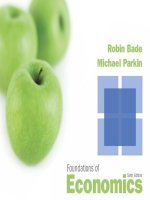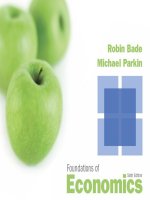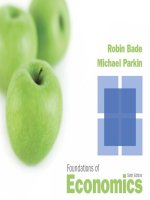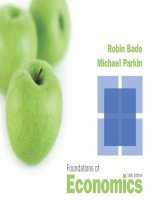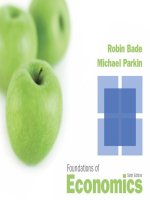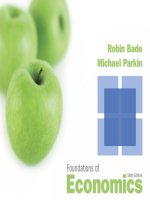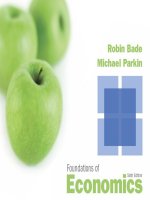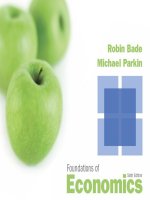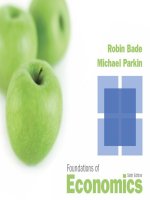Foundaions of economics 6th by robin bade ch09
Bạn đang xem bản rút gọn của tài liệu. Xem và tải ngay bản đầy đủ của tài liệu tại đây (1.92 MB, 68 trang )
© 2013 Pearson
Who wins and who loses
from globalization?
© 2013 Pearson
9
Global Markets in Action
CHAPTER CHECKLIST
When you have completed your
study of this chapter, you will be able to
1 Explain how markets work with international trade.
2 Identify the gains from international trade and its winners
and losers.
3 Explain the effects of international trade barriers.
4 Explain and evaluate arguments used to justify restricting
international trade.
© 2013 Pearson
9.1 HOW GLOBAL MARKETS WORK
Imports are the good and services that we buy from
people in other countries.
Exports are the goods and services we sell to people
in other countries.
© 2013 Pearson
9.1 HOW GLOBAL MARKETS WORK
International Trade Today
The United States is the world’s biggest international
trader and accounts for 10 percent of world exports and
15 percent of world imports.
In 2009, total U.S. exports were $1.5 trillion, which is
about 11 percent of the value of U.S. production.
In 2009, total U.S. imports were $1.9 trillion, which is
about 13 percent of the value of total U.S. expenditure.
© 2013 Pearson
9.1 HOW GLOBAL MARKETS WORK
The United States trades internationally in goods and
services.
In 2009, U.S. exports of services were $0.5 trillion (33
percent of total exports) and U.S. imports of services
were $0.4 trillion (21 percent of total imports).
The largest U.S. exports of goods are airplanes.
The largest U.S. imports of goods are crude oil and
automobiles.
The largest U.S. exports of services are banking,
insurance, business consulting, and other private
services.
© 2013 Pearson
9.1 HOW GLOBAL MARKETS WORK
What Drives International Trade?
The fundamental force that generates trade between
nations is comparative advantage.
The basis for comparative trade is divergent opportunity
costs between countries.
National comparative advantage is the ability of a nation
to perform an activity or produce a good or service at a
lower opportunity cost than any other nation.
© 2013 Pearson
9.1 HOW GLOBAL MARKETS WORK
The opportunity cost of producing a T-shirt is lower in
China than in the United States, so China has a
comparative advantage in producing T-shirts.
The opportunity cost of producing an airplane is lower in
the United States than in China, so the United States
has a comparative advantage in producing airplanes.
Both countries can reap gains from trade by specializing
in the production of the good at which they have a
comparative advantage and then trading.
Both countries are better off.
© 2013 Pearson
9.1 HOW GLOBAL MARKETS WORK
Why the United States Imports T-Shirts
Figure 9.1(a) shows that
with no international trade,
1. U.S. demand and U.S.
supply determine
2. The U.S. price at $8 a
T-shirt and
3. U.S. firms produce at 40
million T-shirts a year
and U.S. consumers buy
40 million T-shirts a year.
© 2013 Pearson
9.1 HOW GLOBAL MARKETS WORK
The demand for and supply of
T-shirts in the world determine
the world price at $5.
The world price is less than $8,
so the rest of the world has a
comparative advantage in
producing T-shirts.
Figure 9.1(b) shows that with
international trade,
4. The price in the United
States falls to $5 a T-shirt.
© 2013 Pearson
9.1 HOW GLOBAL MARKETS WORK
With international trade,
5. Americans increase the
quantity they buy to 60
million T-shirts a year.
6. U.S. garment makers
decrease the quantity
they produce to 20 million
T-shirts a year.
7. The United States imports
40 million T-shirts a year.
© 2013 Pearson
9.1 HOW GLOBAL MARKETS WORK
Why the United States Exports Airplanes
Figure 9.2(a) shows that
with no international trade,
1. Equilibrium in the U.S.
airplane market.
2. The U.S. price is $100
million an airplane and
3. U.S. aircraft makers
produce at 400 airplanes a
year and U.S. airlines
buy 400 a year.
© 2013 Pearson
9.1 HOW GLOBAL MARKETS WORK
The world market for
airplanes determines the
world price at $150 million
an airplane.
The world price is higher
than $100 million, so the
United States has a
comparative advantage in
producing airplanes.
© 2013 Pearson
9.1 HOW GLOBAL MARKETS WORK
Figure 9.2(b) shows that with
international trade,
4. The price of an airplane in
the United States rises to
$150 million.
© 2013 Pearson
9.1 HOW GLOBAL MARKETS WORK
With international trade,
5. U.S. aircraft makers
increase the quantity
they produce to 700
airplanes a year.
6. U.S. airlines decrease the
quantity they buy to 200
airplanes a year.
7. The United States exports
500 airplanes a year.
© 2013 Pearson
9.2 WINNERS, LOSERS, AND NET GAINS FROM TRADE
International trade lowers the price of an imported good
and raises the price of an exported good.
Buyers of imported goods benefit from lower prices and
sellers of exported goods benefit from higher prices.
But some people complain about international competition:
not everyone gains.
Who wins and who loses from free international trade?
We measure the gains and losses by examining the
effects of international trade on consumer surplus,
producer surplus, and total surplus.
© 2013 Pearson
9.2 WINNERS, LOSERS, AND NET GAINS FROM TRADE
Gains and Losses from Imports
1. With no international trade,
the price of a T-shirt in the
United States is $8 and 40
million T-shirts a year are
bought and sold.
2. Consumer surplus is the
area of the green triangle.
3. Producer surplus is the
area of the blue triangle.
© 2013 Pearson
9.2 WINNERS, LOSERS, AND NET GAINS FROM TRADE
With international trade, the
price of a T-shirt falls to the
world price of $5.
4. Consumer surplus
expands from area A to
the area A + B + D.
5. Producer surplus shrinks
to the area C.
© 2013 Pearson
9.2 WINNERS, LOSERS, AND NET GAINS FROM TRADE
The area B is transferred
from producers to
consumers, but
6. Area D is an increase in
total surplus.
Area D is the net U.S. gains
from international trade.
© 2013 Pearson
9.2 WINNERS, LOSERS, AND NET GAINS FROM TRADE
Consumers gain because
they pay less, buy more
T-shirts, and receive a
larger consumer surplus.
Producers lose because
they receive a lower price,
produce fewer T-shirts, and
receive a smaller producer
surplus.
Consumers’ gain exceeds
producers’ loss, so total
surplus increases.
© 2013 Pearson
9.2 WINNERS, LOSERS, AND NET GAINS FROM TRADE
Gains and Losses from Exports
1. With no international trade,
the price of an airplane in
the United States is $100
million and 400 million a
year are bought and sold.
2. Consumer surplus is the
area of the green triangle.
3. Producer surplus is the
area of the blue triangle.
© 2013 Pearson
9.2 WINNERS, LOSERS, AND NET GAINS FROM TRADE
With international trade, the
price of an airplane rises to
the world price of $150
million.
4. Consumer surplus
shrinks to the area A.
5. Producer surplus
expands from area C to
area B + C + D.
© 2013 Pearson
the
9.2 WINNERS, LOSERS, AND NET GAINS FROM TRADE
The area B is transferred
from consumers to
producers, but
6. Area D is an increase in
total surplus.
Area D is the net U.S. gains
from international trade.
© 2013 Pearson
9.2 WINNERS, LOSERS, AND NET GAINS FROM TRADE
Consumers lose because
they pay a higher price, buy
fewer airplanes, and receive
a smaller consumer surplus.
Producers gain because they
receive a higher price,
produce more airplanes, and
receive a larger producer
surplus.
Producers’ gain exceeds
consumers’ loss, so total
surplus increases.
© 2013 Pearson
9.3 INTERNATIONAL TRADE RESTRICTIONS
Governments restrict international trade to protect
domestic producers from competition.
The four sets of tools they use are
• Tariffs
• Import quotas
• Other import restrictions
• Export subsidies
© 2013 Pearson
